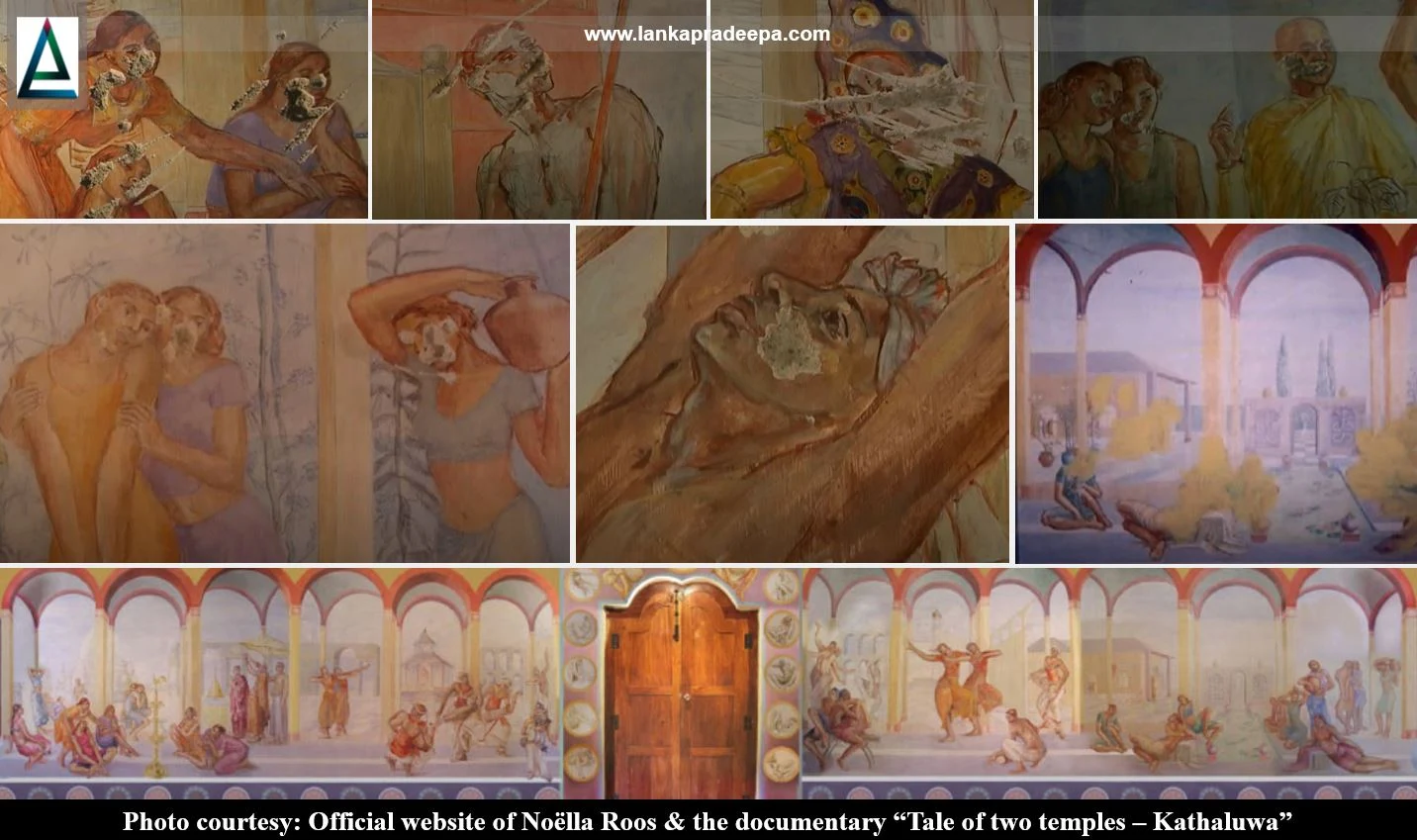
As the invitation of Ven. Kalyanitissa Thera, the incumbent of Kathaluwa Giniwella Nawamuni Se Viharaya in Sri Lanka, three Dutch artists namely, Noëlla Roos, Rachel Dieraert and Eddy Roos carried out a mural art project at the temple with the guidance of local artists and experts (Liyanage, 2004; Roos, 2019; Seneviratne, 2004). The project was begun in 2002 when Kalyanitissa Thera prepared the way for more than 70 people to collaborate with it (Roos, 2019).
The project was financially assisted by the Netherlands Embassy in Colombo (Liyanage, 2004; Roos, 2019; Seneviratne, 2004).
Two temples at Kathaluwa
Giniwella Nawamuni Se Purana Viharaya and Ranwella Purana Viharaya are two Buddhist temples situated adjacent to each other in Kathaluwa village in Galle District. Although there are two temples at the site today, initially there was only one temple, established around 1820. However, due to some issues that arose between two Buddhist sects, Amarapura Nikaya and Siyam Nikaya, it was divided into two temples namely, Ranawella Viharaya and Giniwella Viharaya. Of the two temples, the Dutch mural project was carried out at the Giniwella Viharaya.Dutch murals
The proposed Dutch murals depicting the Dalada Perahera and the arrival of Sangamitta Theri with the Sacred Bo Sapling in Sri Lanka were decided to be drawn over the vacant peripheral walls of the image house (Roos, 2019; Liyanage, 2004). These walls are said to have had some murals from the 1930s, but they were in such poor condition that the Department of Archaeology could not restore them (Roos, 2019).
The project was carried out for three months in 2002 and some work was done in 2004. More than 70 people were involved in this project as models for the murals, primarily from the local neighbourhood (Roos, 2019). The completed murals finally covered an area of 110 square meters on the wall with 140 figures and many Buddhist symbols, composed using the Golden Mean (Roos, 2019). The paintings primarily had drawn in the Western Renaissance style.
Reviews
S.P. Charles, the curator at the National Museum and the key person at the Department of Cultural Affairs is said to have praised these three Dutch artists (Liyanage, 2004; Roos, 2019; Seneviratne, 2004). Also, the project also had received some positive attention from several local media outlets (Roos, 2019).: A news report by Sunday Observer (22 February 2004): Giniwella Purana Vihara (Kataluwa) murals
: A news report by Sunday Times (15 February 2004): Our tradition, their talent; Dutch artists paint temple murals based on Buddhist themes
Criticism
The Dutch artists are said to have received some criticism from a monk in Colombo during the period of the project that was carried out (Roos, 2019). Also, some had accused that the figures in the murals are not in conformity with the traditional Buddhist themes (Liyanage, 2004; Seneviratne, 2004).
Vandalism
On the night of 15 April 2004, an unidentified vandal had damaged 85 faces of the 140 figures in the murals by hacking them away (Liyanage, 2004; Seneviratne, 2004). By 19 April, some parts of the murals had been daubed with a commercial yellow colour painting to destroy them further. In May 2004, this action was claimed by a Buddhist monk named Seelarathana Thera of Shanti Temple, Colombo.
References
1) Liyanage, K.J., 2004. Giniwella temple mural controversy: Concern for tradition or personal politics? A news article from Sunday Observer, published on 2 May 2004.
2) Roos, N., 2019. Kataluwa temple project. From details in the website by Noëlla Roos, one of the three artists who was involved in this project.
3) Seneviratne, V., 2004. Pain after the paint: Act of vandalism raises questions over the Kataluwa temple project. A news article from Sunday Times, published on 25 April 2004.
This page was last updated on 16 May 2022
For a complete tourist map follow this link: Lankapradeepa Tourist Map
For a complete tourist map follow this link: Lankapradeepa Tourist Map

